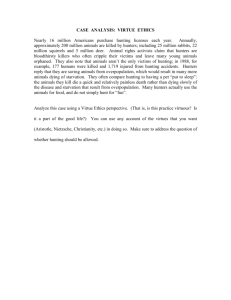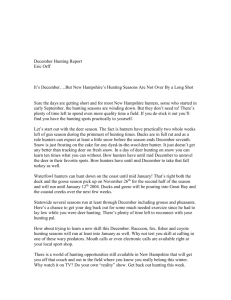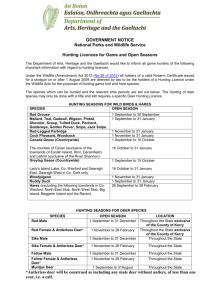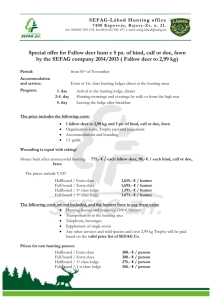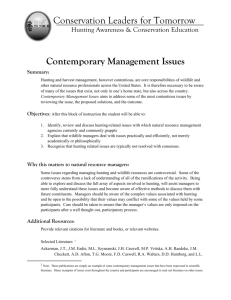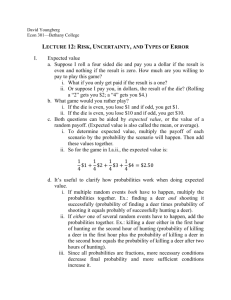To hunt and return - New Zealand Mountain Safety Council
advertisement
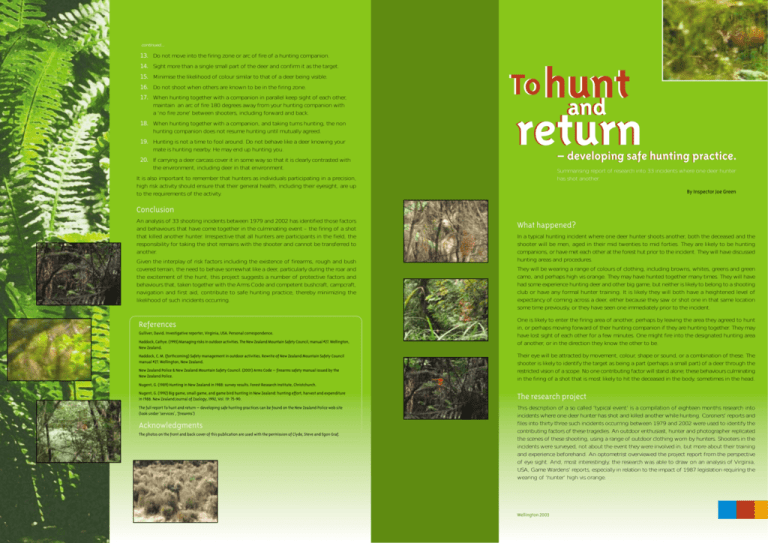
continued... 13. Do not move into the firing zone or arc of fire of a hunting companion. 14. Sight more than a single small part of the deer and confirm it as the target. 15. Minimise the likelihood of colour similar to that of a deer being visible. 16. Do not shoot when others are known to be in the firing zone. 17. When hunting together with a companion in parallel keep sight of each other, maintain an arc of fire 180 degrees away from your hunting companion with a ‘no fire zone’ between shooters, including forward and back. 18. When hunting together with a companion, and taking turns hunting, the non hunting companion does not resume hunting until mutually agreed. 19. Hunting is not a time to fool around. Do not behave like a deer knowing your mate is hunting nearby. He may end up hunting you. To hunt and return – developing safe hunting practice. 20. If carrying a deer carcass cover it in some way so that it is clearly contrasted with the environment, including deer in that environment. Summarising report of research into 33 incidents where one deer hunter has shot another. It is also important to remember that hunters as individuals participating in a precision, high risk activity should ensure that their general health, including their eyesight, are up to the requirements of the activity. By Inspector Joe Green Conclusion An analysis of 33 shooting incidents between 1979 and 2002 has identified those factors and behaviours that have come together in the culminating event – the firing of a shot that killed another hunter. Irrespective that all hunters are participants in the field, the responsibility for taking the shot remains with the shooter and cannot be transferred to another. Given the interplay of risk factors including the existence of firearms, rough and bush covered terrain, the need to behave somewhat like a deer, particularly during the roar and the excitement of the hunt, this project suggests a number of protective factors and behaviours that, taken together with the Arms Code and competent bushcraft, campcraft, navigation and first aid, contribute to safe hunting practice, thereby minimizing the likelihood of such incidents occurring. References Gulliver, David. Investigative reporter, Virginia, USA. Personal correspondence. Haddock, Cathye. (1993) Managing risks in outdoor activities. The New Zealand Mountain Safety Council, manual #27. Wellington, New Zealand. Haddock, C. M. (forthcoming) Safety management in outdoor activities. Rewrite of New Zealand Mountain Safety Council manual #27. Wellington, New Zealand. New Zealand Police & New Zealand Mountain Safety Council. (2001) Arms Code – firearms safety manual issued by the New Zealand Police. What happened? In a typical hunting incident where one deer hunter shoots another, both the deceased and the shooter will be men, aged in their mid twenties to mid forties. They are likely to be hunting companions, or have met each other at the forest hut prior to the incident. They will have discussed hunting areas and procedures. They will be wearing a range of colours of clothing, including browns, whites, greens and green camo, and perhaps high vis orange. They may have hunted together many times. They will have had some experience hunting deer and other big game, but neither is likely to belong to a shooting club or have any formal hunter training. It is likely they will both have a heightened level of expectancy of coming across a deer, either because they saw or shot one in that same location some time previously, or they have seen one immediately prior to the incident. One is likely to enter the firing area of another, perhaps by leaving the area they agreed to hunt in, or perhaps moving forward of their hunting companion if they are hunting together. They may have lost sight of each other for a few minutes. One might fire into the designated hunting area of another, or in the direction they know the other to be. Their eye will be attracted by movement, colour, shape or sound, or a combination of these. The shooter is likely to identify the target as being a part (perhaps a small part) of a deer through the restricted vision of a scope. No one contributing factor will stand alone; these behaviours culminating in the firing of a shot that is most likely to hit the deceased in the body, sometimes in the head. Nugent, G. (1989) Hunting in New Zealand in 1988: survey results. Forest Research Institute, Christchurch. Nugent, G. (1992) Big game, small game, and game bird hunting in New Zealand: hunting effort, harvest and expenditure in 1988. New Zealand Journal of Zoology, 1992, Vol. 19: 75-90. The research project The full report To hunt and return – developing safe hunting practices can be found on the New Zealand Police web site (look under ‘services’, ‘firearms’) This description of a so called ‘typical event’ is a compilation of eighteen months research into incidents where one deer hunter has shot and killed another while hunting. Coroners’ reports and files into thirty three such incidents occurring between 1979 and 2002 were used to identify the contributing factors of these tragedies. An outdoor enthusiast, hunter and photographer replicated the scenes of these shooting, using a range of outdoor clothing worn by hunters. Shooters in the incidents were surveyed, not about the event they were involved in, but more about their training and experience beforehand. An optometrist overviewed the project report from the perspective of eye sight. And, most interestingly, the research was able to draw on an analysis of Virginia, USA, Game Wardens’ reports, especially in relation to the impact of 1987 legislation requiring the wearing of ‘hunter’ high vis orange. Acknowledgments The photos on the front and back cover of this publication are used with the permission of Clyde, Steve and Egon Graf. Wellington 2003 Principles of outdoor safety management What colour to wear? The New Zealand Mountain Safety Council manual Managing risk in outdoor activities and its forthcoming rewrite, Safety management in outdoor activities, are core sources for the principles of outdoor safety (risk) management. A number of social and psychological factors relating to safety (risk) management that apply to other outdoor activities also apply to hunting. These include: The database of the Virginia (USA) Game Wardens’ reports was analysed according to parameters that were limited to deer hunters hunting deer where visual identification was an issue, and a comparison of pre 1987 accident rates with post 1987 accidents made, to measure if the legislated requirement to wear high vis orange had made an impact. In nearly two thirds of cases (63.9%) of deer hunting accidents in Virginia involving firearms where shooter targeting was a factor the victim was wearing orange to the legal requirement. The median for all target related shooting was the same for the years 1977-1988 and 1998-2001. The inescapable conclusion is, therefore, that the legislated requirement to wear high vis orange has had negligible, if any impact on the number of deer hunters shot in incidents in which target identification was a factor. Anecdotal comment here in New Zealand suggests that the wearing of high vis orange may have prevented individual incidents. These are generally not reported in any systematic way, and appear to be based on the supposition that to be visible by wearing high vis orange averts shooting incidents – such a supposition is not, on the face of it, supported by the Virginia data. However there is still good reason to suggest that hunters should wear clothing that contrasts with the environment, including deer in that environment. There is no reason to believe that deer can, or cannot see any one colour better than another, rather it is movement that deer see best, and that gives the hunter away. • Familiarization with the situation, ‘where continued exposure to a hazard in a frequently used area reduced the leader/s perception of risks associated with the hazards’, with a resultant belief that ‘it can’t happen to me’. • Dropping your guard, often on the return from the outdoor activity. • Risk shift, or the transfer of responsibility for managing risks, occurs when a person places the responsibility for safety management onto someone else. • Attribution theory, the tendency to take credit for positive behaviours or outcomes but to deny responsibility for bad or negative ones. This stems from the human desire to be seen in a good light. • For the hunter the phenomenon known as ‘stag, or buck fever’ needs to be added to the list of social and psychological factors. Stag or buck fever might best be described as a high expectation of seeing or shooting a deer, such that the excitement and emotion over rides rational thinking. It appears that stag/buck fever can strike even the most experienced of hunters. The social and psychological aspects of outdoor safety (risk) management underpinned and informed the research project. They enable us to look beyond the shot fired, seeing it as a culminating event that has a series of contributing events. Who were they? – shooter and deceased In every case both the shooter and the deceased were deer hunters. According to research carried out in 1989 by Nugent, they were part of a group of about 38 000 people who clocked up a median of 260 000 days deer hunting in the year, shooting about 80 000 deer. Within this context, and given an average of 1.5 incidents in the years 1979-2002, the shooting of one hunter by another is a very rare, but no less tragic event. The shooter and deceased were all men, ranging in age from 15 to over 60, with an average age of about 31 years. In about two thirds of cases the shooters were experienced deer hunters, having either hunted for a number of years, and/or having shot a number, in some cases a large number, of deer. In the 23 cases in which it was indicated they were Caucasian, with the ethnicity of the shooter and deceased in the remaining 10 cases not known. In about two thirds of cases they were in the same party, and in just over half the incidents the shooter knew that the deceased was in the area. It could be said that deer hunters are shooting their mates, knowing they are in the area where the shot was fired! The survey of shooters indicated that a shooter is unlikely to be a member of a shooting club. Only one of the ten shooters who responded had any hunter specific training. So what contributed to the incidents? While the cause of death in each case was the shot fired by the shooter, and the shooter always retains responsibility for that, both the shooter and the deceased did things that contributed to the incident. Target identification was a factor in just under two thirds (64%) of cases. This happened when a flash of clothing or skin was mistaken for a deer, often the back end of the animal. Some shooters stated that they clearly identified they were looking at a deer, including in one case the head, ears, and neck. In another case the shooter saw what he thought was the back of an animal, including its tail. One saw movement in the bushes, and what he thought were antlers. In some cases the deceased had moved into the firing zone of the shooter, without the shooter being aware they had done this, and in several cases without the deceased even being sighted. In several cases the shooter shot into an area, perhaps a gully or bluff, knowing that their hunting mate had gone into the area. In some of these cases it wasn’t the shooters turn to hunt. In other cases the shooter had shot into, or in the direction of their hunting mates ‘block’. Nearly all shootings took place in a bush environment, with either the shooter, the deceased or both in the bush. Most occurred on the public estate. The distance of shootings ranged from 6 to 90 metres, with the average being 35 metres. The time of the shooting is recorded in 26 of the 33 incidents. Contrary to popular belief, 85% of the shootings took place during the hours of daylight, and were spread evenly throughout the day. None of the incidents analysed took place at night. In the cases where it was canvassed, and given the shooters description of what they shot at in most other cases, there is nothing to support any assertion that colour blindness or other vision related issues are contributing factors. The colour recognition project The objective of the colour recognition project was to ascertain what colours were most visible in a range of hunting environments in New Zealand, replicating those in which shooting had occurred. The results are best communicated photographically. No one colour is satisfactory as a protective factor for all conditions, however ‘United Nations’ blue came out as the most visible colour in the greatest variety of conditions, but can be affected by going darker when wet if made of an absorbent material. A range of high vis orange clothing was tested. It was good in most conditions, but there are circumstances where it might be confused with deer, especially in some light conditions. The outcomes of this project indicate that the wearing of colour that contrasts with the environment, on its own, is not sufficient. Rather, hunters need to modify a range of behaviours. Changing behaviour Hunters can minimize the likelihood of shooting, or being shot by, another hunter by modifying a range of behaviours. These are listed in descending order of the frequency in which the corresponding contributing factor appears in the incidents analysed (that is, the first is the most common contributing factor). Including bush, navigation, first aid and camp craft skills, and careful compliance with the New Zealand Arms Code: 1. A hunter must not shoot at shape, sound, movement or colour, including those that belong to a deer, without confirming that their target is a deer. 2. A wise hunter will wear clothing that contrasts with the environment, including deer in that environment. 3. When hunting together with a companion, cease hunting if visual contact with that companion is lost, and do not resume hunting until visual contact is made and confirmed. 4. A hunter must develop a self-awareness that enables them to identify buck/stag fever in themselves, and counteract it with extra care while hunting. 5. Use binocular vision to identify the target; use the scope only to place the shot. 6. Snap shooting is to be avoided unless target identification is complete. 7. If an area is obviously heavily occupied by other hunters consider going hunting elsewhere. 8. Hunters should undergo hunter specific training. 9. Hunters should belong to a club. Club membership is most likely to be the source of training and peer guidance. 10. Hunters should agree on hunting areas (‘blocks’), with a clearly defined ‘no fire zone’ between areas. Do not hunt outside the agreed area, including on the way back to camp. 11. If a linear boundary is agreed (for example a ridge line or creek), no shots may be fired toward or over that boundary line. 12. If it is absolutely necessary for one hunter to knowingly move into another’s area, perhaps because of an emergency, do not stalk into the area. The hunter should enter in a way that it is obvious they are not a deer. continued on back page...

